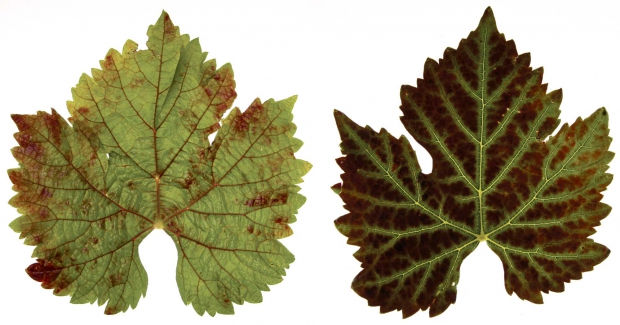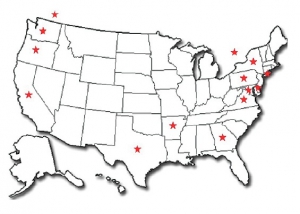
(LEFT) A leaf from Merlot grapevine showing red veins and red blotches on margins and interveinal regions, typical symptoms of red blotch disease. (RIGHT) Cabernet franc leaf showing green veins and interveinal reddening, typical symptoms of grapevine leafroll disease. (Courtesy of Washington State University)
A newly recognized virus has Washington State’s wine grape industry seeing red, and not just from red blotchy leaves, symptoms of the disease.
The emerging disease is frustrating to those who used certified plant material tested to be free of known viruses—and could have the new disease anyway. But it’s also a learning opportunity and demonstrates the need for vigilance when it comes to grape diseases.
The new virus, called grapevine red blotch-associated virus, was first recognized in 2008 in a Napa, California, vineyard. It’s so new that scientists are still learning about it.
“What we do know is how to recognize it in vineyard situations,” said Dr. Marc Fuchs, plant pathologist at Cornell University.
Symptoms are red blotches or specks on leaves near harvest, often starting in the center and spreading out to the upper portion of the leaf. Older leaves may fall off prematurely.
“A telling symptom is that the primary and secondary veins on the leaf underside turn red,” he said, “but red veins by themselves are not descriptive of the virus. You have to see red specks also on the upper part of the leaf to know.”
Fuchs made his comments at the annual meeting of the Washington Association of Wine Grape Growers in February.

Map of red leaf blotch disease detections in North America.(Illustration courtesy Marc Fuchs, Cornell University)
Red blotch virus has been confirmed in all types of grapes and in all kinds of rootstocks from coast to coast and in Canada, he said.
Although initial reports point to the disease being a North American problem, Fuchs believes that with the global movement of plant material, it will be found wherever grapes are grown.
The virus has been extensively dispersed across the United States and detected in at least ten states and in two Canadian provinces.
“There’s little doubt that is has spread through propagation and uncontrolled use of infected grafting material,” Fuchs said, but added that more research is needed to definitively identify the means of transmission. “On the East Coast, there’s been no evidence of red blotch moving vine to vine or from vineyard to vineyard. But California is a different situation. A few exceptions there suggest that the virus has spread.”
Washington State University scientists found that Virginia creeper leafhopper (Erythroneura ziczac) was capable of transmitting the virus from vine to vine under confined, greenhouse conditions. Research is needed to confirm the insect’s ability to vector red blotch in the field field.
The virus significantly impacts fruit quality and affects ripening.
“There have been reports of Brix being reduced by five to six degrees at harvest,” Fuchs said, “but so far there are no indications of effects on yields, like those of grapevine leafroll virus. The new virus also substantially reduces anthocyanins and tannin compounds in grapes.”
Scientists have developed a diagnostic assay to identify the disease. Tissue samples (leaves, petioles, dormant canes, etc.) can be tested at any time during the growing season using PCR (polymerase chain reaction) assays.
Mistaken identity
Many scientists believe that red blotch has been in the grape industry for some time, originally being mistaken for grapevine leafroll disease. In East Coast grape-growing regions, Fuchs has found the virus in young and old vineyards, some as old as 30 years.
“We think it’s been around for some time, we just didn’t recognize it as a new disease,” he said.
In 2005, Dr. Naidu Rayapati, WSU plant pathologist, received a call from a Benton City, Washington, grape grower who was concerned about leafroll virus in a Syrah block. “Testing was negative for leafroll, so the grower thought the red leaves were related to nutrition,”
Rayapati said. The block still had symptoms after several years of nutritional amendments, so last year it was tested again. “We found it had red blotch virus.”
Both red blotch and leafroll viruses show similar red leaf symptoms in red grape varieties. Leafroll virus is subtler in white varieties.
WSU’s Rayapati believes that when the new virus first showed up in Washington, everyone thought it was leafroll. Those whose vines tested negative for leafroll mistakenly assumed leaf symptoms were related to nutrition or other factors.
“Don’t assume if you have red leaves that you have leafroll disease,” said Rayapati. “If you have tested your vineyard in the past for leafroll and tests were negative, it could be that you had red blotch instead.”
Tests have confirmed that the virus is found in several appellations within the state. While he doesn’t think red blotch is rampant in Washington vineyards, “it is here,” Rayapati said, though incidence is lower than leafroll virus.
Of note is the widespread detection of red blotch in Merlot clone 15. “Merlot 15 was a ‘hot’ clone in short supply from nurseries, so many growers sourced cuttings from vineyards instead of certified nurseries,” Rayapati said. “They tested the vineyard for leafroll and, finding none, propagated wood for expanded plantings.”
Rayapati and state officials are in the second year of testing mother blocks of certified nurseries in the state for red blotch and other diseases, a project funded by a specialty crop block grant of the Washington State Department of Agriculture. Thus far, the new disease has not been detected in any mother blocks.
Several other specialty crop grants, managed by the Washington Wine Industry Foundation, have funded disease education and outreach as well as the development and printing of a disease identification pocket field guide.
The pocket guide is designed for use by vineyard employees and will be distributed later this year in Spanish and English versions.
Learning experience
Rayapati said the new virus, while frustrating to growers who planted certified material, is a learning experience for the industry.
“When it comes to viruses, growers can’t be complacent and assume that certified material means vines are free of all diseases,” he said. Certified means the vine is only free of those viruses for which it was tested.
Washington’s agricultural department is in the process of updating state regulations to add red blotch to the list of quarantined viruses and insects for imported plant material.
“For now, growers, when purchasing plant material from any nursery, should ask what viruses the stock has been tested for,” Rayapati said. “You need to ask if the planting stock has been tested for red blotch because it may not have been.”
Most importantly, if you find red leaves in your vineyard, test for a full panel of diseases, not just leafroll.
“It’s like learning whether you have the flu or bronchitis,” he said. “Both are bad, with similar symptoms, but have different treatments. You need to know what virus you have so you can better manage it.”
Red blotch has more impact on yield and fruit sugars compared to leafroll, so reducing cropping levels may be a tool that helps in managing the virus.
“The new virus didn’t just fall out of the sky last year,” he said, noting that it was probably here for some time, but its slow movement helped the disease stay under the radar. •






Leave A Comment